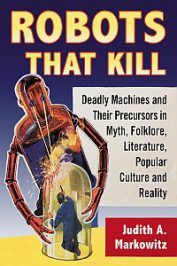In three parts, Judith Markowitz deals with the phenomenon of evil or rather, human-killing robots (and their creators) in the book at hand.
In part 1, greed, revenge and furor are taken into consideration in cases why humans had to die by “the hands” of a robot, that was more or less only used as a tool or agent without pity.
 Part 2 specifies crimes or crime control, both organized by robots; those could be in law enforcement or function as tormentors, sadists, or killers. This chapter provides several types and precursors.
Part 2 specifies crimes or crime control, both organized by robots; those could be in law enforcement or function as tormentors, sadists, or killers. This chapter provides several types and precursors.
The final section focuses on war and war-like scenarios, when humanoids act as assassins, comrades, brothers-in-arms to humans, killing machines or spies.
Generally, robots perform diverse both negative and benevolent functions, for example, while they facilitate dangerous works, they also are job-killers; one result that occurs often in fiction is the (clandestine) replacement of humans by robot doppelgangers. However, there is as well a relatively high number of killings by robots in fiction and popular culture that happen “for no apparent reason. … There are a few whose behavior may be truly inexplicable. Quite often, however, there is or was something that compelled them to kill widely and indiscriminately.”
Readers will encounter many characters (mostly robots, androids, humanoids and all kinds between) from various media and popular culture universes, be they from Terminator, Star Wars, Star Trek, Blade Runner, Doctor Who, The Day the Earth Stood Still, or Eureka. Very many contemporary novels, comic books, computer game characters, superheroes, mangas and movies are mentioned during the history of not so friendly robots and readers will run across characters (and robots) such as Commander Data, the Cybermen, Tomorrow Woman, the Mighty Atom, replicants, Ghost in a Shell, the Borg and many others.
Luckily, the selection of robots mentioned exceeds the well-known names and also cites hundreds less widely known works of fiction from the last 150 years or so.
The sectional approach to each subtopic, closing each text with a reality check/state of the art, examples in “Modern Literature,” the “Real World,” and “Contemporary Media” is somewhat irritating at first, as it is a break in the structure of each topic, but often makes sense after one gets used to it.
What may disappoint some who were out to read about robots, is the inclusion of many purely mythological (sometimes summoned) creatures and not at all manufactured robots, as most readers would define those machines. The listing of the robot’s precursors, according to Markowitz, include the Golem, the Tupilak, oracular heads, Tulpas, Otarks, characters in “Edisonades” (stories that feature an inventor of technology who builds robots and other tools to conquer) and many more. Some robots or their precursors originated as part of ancient myth and folklore from anywhere on the planet; so discovering robots that carry out murders or threats sometimes is the modern-day representation of old gods, mythological creatures or summoned revenge agents. Those original tales and folklore – where often the link to the modern robot is somehow missing in the chapters – make up for roughly two-thirds of the book.
Strangely enough then, some very popular works are not mentioned at all, although robots play extremely important roles there, such as in Battlestar Galactica and the prequel Caprica (stories that deal almost exclusively with the problem of robots and the possible extinction of mankind by the hand of them), or The Orville, where for some episodes, biological life has to face the exact problem. The world’s longest running weekly science fiction novella print series Perry Rhodan (from Germany, more than 2 billion copies sold in 3,000 episodes since 1961) whose multi universes are populated by hundreds of robot characters, cyborgs and aggressive robot societies is mentioned in one sentence. Westworld (the 1973 movie and the 2016 series), where robots that kill are actually at the very center of the story and the idea of entirely self-aware robots that kill out of their miraculously developed free will (and not following orders or a program) is referred to in two paragraphs only.
All in all, a good introduction, but as many main “robot problems” and already highly elaborate writing and film productions dealing with killing bots are not explored in depth but are only briefly mentioned in favor of a very long part that muses on magical creatures and mythological avengers and monsters, not a really convincing title. Unfortunately, a concluding chapter is missing, too, despite all the work that must have gone into the texts.
Review by Dr. A. Ebert © 2020
Judith A. Markowitz. Robots That Kill: Deadly Machines and Their Precursors in Myth, Folklore, Literature, Popular Culture and Reality. McFarland, 2019, 247 p.
